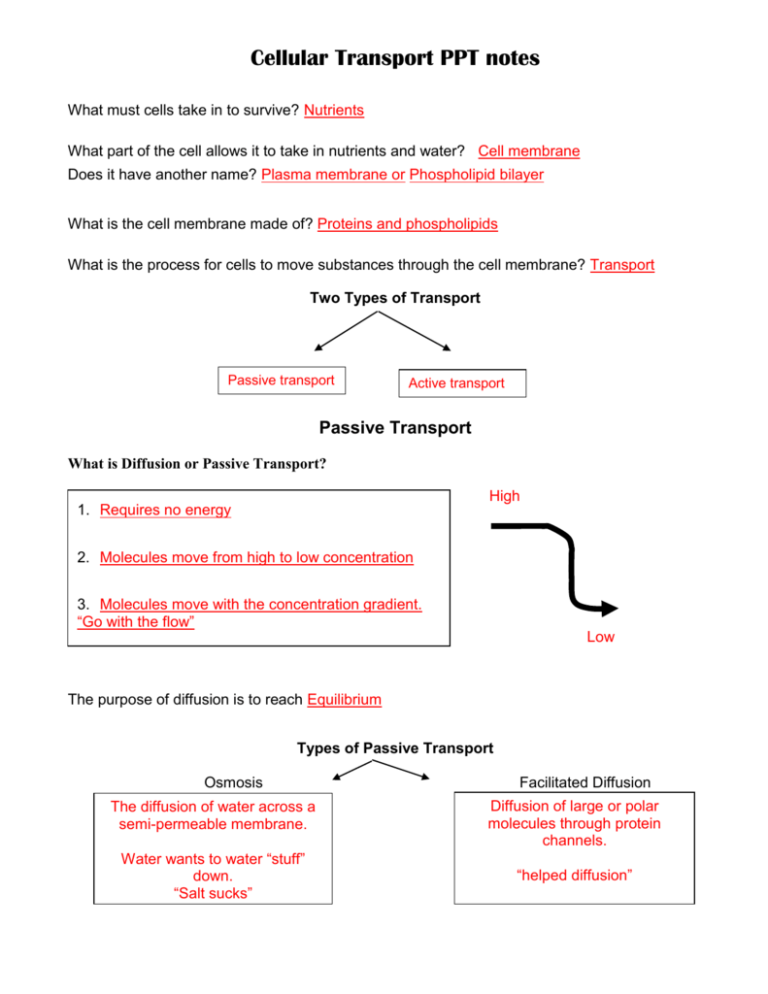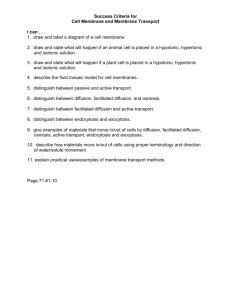Types of Passive Transport
advertisement

Cellular Transport PPT notes What must cells take in to survive? Nutrients What part of the cell allows it to take in nutrients and water? Cell membrane Does it have another name? Plasma membrane or Phospholipid bilayer What is the cell membrane made of? Proteins and phospholipids What is the process for cells to move substances through the cell membrane? Transport Two Types of Transport Passive transport Active transport Passive Transport What is Diffusion or Passive Transport? High 1. Requires no energy 2. Molecules move from high to low concentration 3. Molecules move with the concentration gradient. “Go with the flow” Low The purpose of diffusion is to reach Equilibrium Types of Passive Transport Osmosis The diffusion of water across a semi-permeable membrane. Water wants to water “stuff” down. “Salt sucks” Facilitated Diffusion Diffusion of large or polar molecules through protein channels. “helped diffusion” Explain what is happening during osmosis. The _water__ molecules are moving from __high concentration to __low concentration in order to reach __euilibrium___. In other words…. Water moves to wherever there is more “stuff” like salt, sugar, etc. More stuff means less water. “salt sucks”. OBSERVATIONS OF OSMOSIS 80% H2O 80% H2O 100% Distilled Water Hypotonic solution 80% Water 20% Isotonic solution Dissolved Substances 80% H2O 70% Water 30% Hypertonic solution Dissolved Substances What is a Hypertonic solution? What happens to the cell in this solution? Hypertonic has more “stuff” in it than the cell. The cell loses water and shrinks. What is a Hypotonic solution? What happens to the cell in this solution? Hypotonic has less “stuff” in it than the cell. The cell gains water and swells (possibly pops or lyses) What is an Isotonic solution? What happens to the cell in this solution? Isotonic has the same amount of “stuff” as the cell. Water moves in both directions equally (equilibrium). Help Wanted! Explain facilitated diffusion: Larger molecules can’t just diffuse across the cell membrane, they need a “doorway”. Proteins that are in the cell membrane act like doorways. Some are like hallways and some are like swinging doors. Review D F A C B E . . . . . . 1. 2. 3. 4. 5. 6. Cell membrane Proteins and lipids Active and Passive Diffusion Osmosis Facilitated diffusion a. b. c. d. e. f. two types of transport movement of water across a membrane movement of substances across a membrane part of the cell that regulates what goes in and out movement assisted with channel proteins. two components of the cell membrane ACTIVE TRANSPORT How is Active Transport different from Passive Transport? High 1. Active transport requires energy 2.Molecules move from low concentration to high concentration 3. Molecules move against the concentration. “Swimming against the flow” Low Types of Active Transport Enters the cell Endocytosis Engulfs particle Phagocytosis: cell eating passive transport active transport Exits the cell Exocytosis Liquids Pinocytosis: cell drinking Review energy concentration gradient Not needed High to low Goes with the flow Goes against the flow Requires energy Low to high What part of the cell is used to bring in particles? Cell membrane How does a cell (including white blood cells) take in LARGE particles? Phagocytosis How does a cell take in small or liquid particles? Pinocytosis








